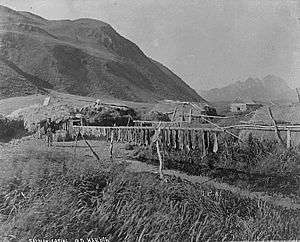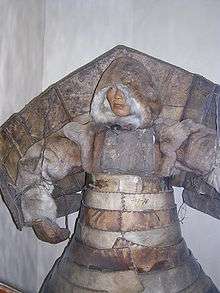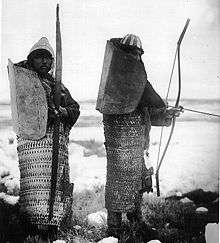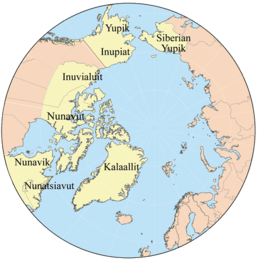Alutiiq
The Alutiiq people (pronounced /əˈluːtɪk/ in English; from Promyshlenniki Russian Алеутъ, "Aleut";[1][2][3] plural often "Alutiit"), also called by their ancestral name Sugpiaq (/ˈsʊɡˌbjɑːk/ or /ˈsʊɡpiˌæk/; plural often "Sugpiat"), as well as Pacific Eskimo or Pacific Yupik, are a southern coastal people of Alaska Natives.
 A Sugpiaq dancer | |
| Regions with significant populations | |
|---|---|
| Languages | |
| Sugcestun, English, Russian | |
| Religion | |
| Russian Orthodox Church, traditional religion | |
| Related ethnic groups | |
| Yup'ik, Aleut |

Their traditional homelands include Prince William Sound and outer Kenai Peninsula (Chugach Sugpiaq), the Kodiak Archipelago and the Alaska Peninsula (Koniag Alutiiq). In the early 1800s there were more than 60 Alutiiq villages in the Kodiak archipelago, with an estimated population of 13,000 people. Today more than 4,000 Alutiiq people live in Alaska.[4]
Terminology
At present, the most commonly used title is Alutiiq (singular), Alutiik (dual), Alutiit (plural). These terms derive from the names (Алеутъ, Aleut) that Russian fur traders and settlers gave to the native people in the region.[5] Russian occupation began in 1784, following their massacre of hundreds of Sugpiat at Refuge Rock (Awa'uq) just off the coast of Sitkalidak Island near the present-day village of Old Harbor (Nuniaq).[6]
Given the violence underlying the colonial period, and confusion because the Sugpiaq term for Aleut is Alutiiq, some Alaska Natives from the region have advocated use of the terms that the people themselves use to describe their people and language: Sugpiaq (singular), Sugpiak (dual), Sugpiat (plural) — to identify the people (meaning "the real people"), and Sugstun, Sugcestun, Sugt'stun, or Sugtestun to refer to the language. All three names (Alutiiq, Aleut, and Sugpiaq) are used now, according to personal preference.[7] Over time, many other ethnonyms were used to refer to this people.[8]
Culture


Fishing and housing
The people traditionally lived a coastal lifestyle, subsisting primarily on ocean resources such as salmon, halibut, and whale. They supplemented these maritime foods with rich land resources, such as berries and land mammals. Before contact with Russian fur traders, they lived in semi-subterranean homes called ciqlluaq. Today, in the 21st century, the Alutiiq live in coastal fishing communities in more modern housing. They work in all aspects of the modern economy, while also maintaining the cultural value of subsistence.
Language
In 2010 the high school in Kodiak responded to requests from Alutiiq students and agreed to teach the Alutiiq language. It is one of the Eskimo–Aleut languages, belonging to the Yup'ik branch of these languages.[10] The Kodiak dialect of the language was being spoken by only about 50 persons, all of them elderly, and the dialect was in danger of being lost entirely.[11]
Notable Alutiit
- Alvin Eli Amason, painter and sculptor
- Cungagnaq, also known as Peter the Aleut, an Eastern Orthodox saint, reportedly from Kodiak Island.
- Loren Leman, Lieutenant-governor of Alaska, 2002-2006
- Sven Haakanson, executive director of the Alutiiq Museum, and winner of a 2007 MacArthur Fellowship.[12]
See also
References
- Report on Population and Resources of Alaska at the Eleventh Census: 1890 by United States Census Office - Alaska - 1893 (= "The Kaniagmiut, to whom the Russians applied the name of Aleut")
- East Prince William Sound Landscape Assessment, Cordova Ranger District, Chugach National Forest. September 9, 2008 (= "The term Alutiiq is the Sugtestun pronunciation of the Russian-introduced name Aleut and is commonly used as a self-designation by the people of the Chugach region")
- Mapping Alaska's Native languages Archived 2015-01-06 at the Wayback Machine (= Names derived from a combination of Russian and Native words include: Alutiiq, from the Russian word Aleut (a term something like English "Eskimo" but referring to the people of the Aleutian Islands, the Alaska Peninsula, and the Kodiak archipelago); plus the Russian plural suffix -y; plus the Native singular suffix -q)
- "Alutiiq / Suqpiaq Nation", Alutiiq Museum
- Laurie Shannon Richmond (2011), "Regulating a Mystery: Science, colonialism, and the politics of knowing in the Pacific halibut commons" Archived 2013-01-24 at the Wayback Machine, Conservancy, February 2011
- Pullar, Gordon L. 2010. Assimilation and Identity among the Kodiak Island Sugpiat Archived 2018-07-09 at the Wayback Machine, 2010
- "Looking Both Ways", Museum of Natural History, Smithsonian Institution]
- Medeia Csoba DeHass, "What is in a Name?: The Predicament of Ethnonyms in the Sugpiaq-Alutiiq Region of Alaska" Archived 2020-05-18 at the Wayback Machine, Arctic Anthropology. January 2012, pp. 49:3-17 (= "Aleut," "Alutiiq," "Sugpiaq," "Russian," "Pacific Eskimo," "Unegkuhmiut," and "Chugach Eskimo" are all different names that have been used to identify the group of Native people living on the Lower Kenai Peninsula of Alaska.)
- "Tlingit, Eskimo and Aleut armors." Archived 2014-02-22 at the Wayback Machine Kunstamera. Accessed 10 Feb 2014.
- Michael Krauss: "Alaska Native Languages in Russian America." In: Barbara S. Smith & Redmond J. Barnett, Russian America: The Forgotten Frontier, pp. 205–213. Washington State Historical Society, Tacoma, WA, 1990.
- "Kodiak High School Adding Alutiiq Language Class", Jacob Resnick KMXT/Alaska Public Radio Network 12-17-2010
- "2007 Fellows Individual Pages - MacArthur Foundation". Archived from the original on 2012-03-15. Retrieved 2018-10-14.
Further reading
- Braund, Stephen R. & Associates. Effects of the Exxon Valdez Oil Spill on Alutiiq Culture and People. Anchorage, Alaska: Stephen R. Braund & Associates, 1993.
- Crowell, Aron, Amy F. Steffian, and Gordon L. Pullar. Looking Both Ways; Heritage and Identity of the Alutiiq People. Fairbanks, Alaska: University of Alaska Press, 2001. ISBN 1-889963-30-5
- Harvey, Lola. Derevnia's Daughters, Saga of an Alaskan Village. A story about the Old Village of Afognak up to and including the strongest earthquake ever recorded on the North American continent and the resulting tsunami of March 27, 1964. 1991 ISBN 0-89745-135-X
- Lee, Molly. 2006. ""If It's Not a Tlingit Basket, Then What Is It?": Toward the Definition of an Alutiiq Twined Spruce Root Basket Type", Arctic Anthropology. 43, no. 2: 164.
- Luehrmann, Sonja. Alutiiq Villages Under Russian and U.S. Rule. Fairbanks: University of Alaska Press, 2008. ISBN 978-1-60223-010-1
- Mishler, Craig. 1997. "Aurcaq: Interruption, Distraction, and Reversal in an Alutiiq Men's Dart Game", The Journal of American Folklore. (Vol. 110, no. 436): 189-202.
- Mishler, Craig. 2003. Black Ducks and Salmon Bellies: An Ethnography of Old Harbor and Ouzinkie, Alaska. Donning Company Publishers. Distributed by the Alutiiq Museum & Archaeological Repository, Kodiak, Alaska.
- Mishler, Craig, and Rachel Mason. 1996. "Alutiiq Vikings: Kinship and Fishing in Old Harbor, Alaska", Human Organization : Journal of the Society for Applied Anthropology (Vol.55, no. 3): 263-269.
- Mulcahy, Joanne B. Birth & Rebirth on an Alaskan Island; The Life of an Alutiiq Healer. Athens: University of Georgia Press, 2001. ISBN 0-8203-2253-9
- Partnow, Patricia H. Making History Alutiiq/Sugpiaq Life on the Alaska Peninsula. Fairbanks, Alaska: University of Alaska Press, 2001. ISBN 1-889963-38-0
- Simeonoff, Helen J., and A. L. Pinart. Origins of the Sun and Moon Alutiiq Legend from Kodiak Island, Alaska, Collected by Alphonse Louis Pinart, March 20, 1872. Anchorage, Alaska (3212 West 30th Ave., Anchorage 99517-1660): H.J. Simeonoff, 1996.
- "The Afognak Alutiiq People: Our History and Culture" (PDF). Afognak Native Corporation. 2008. Archived from the original (PDF) on 2013-11-13. Retrieved 2014-11-15.
- "Afognak Village Timeline". Afognak Native Corporation. Retrieved 2014-11-15.
- East Prince William Sound Landscape Assessment. "East Prince William Sound Landscape Assessment" (PDF).
- Ben Fitzhugh (2003). The Evolution of Complex Hunter-Gatherers: archaeological evidence from the North Pacific. Kluwer Academic/Plenum Publishers.
- United States Census Office (1893). "Report on Population and Resources of Alaska at the Eleventh Census: 1890".
- Sven Haakanson (2010). Written Voices Become History. Left Coast press.
- Holton, Gary. "Mapping Alaska's Native languages". Alaska Native Language Center. Archived from the original on 2015-01-06. Retrieved 2014-11-15.
Names derived from a combination of Russian and Native words include: Alutiiq, from the Russian word Aleut; plus the Russian plural suffix -y; plus the Native singular suffix -q
- Miller, Gwenn A. (2010). Kodiak Kreol: Communities of Empire in Early Russian America. Ithaca, NY: Cornell University Press. ISBN 978-0-8014-4642-9.
- "About the Alutiiq People".
- Jacob Resnick. "Kodiak High School Adding Alutiiq Language Class". Alaska Public Radio Network.
- Laurie Shannon Richmond (2011). Regulating a Mystery: Science, colonialism, and the politics of knowing in the Pacific halibut commons (PDF). Archived from the original (PDF) on 2013-01-24.
External links
- Alaska Native Language Center: Alaska Native Languages Map
- Alaskan Orthodox Christian texts (Alutiiq)
- Alutiiq Museum
- List of Native American peoples in the United States
